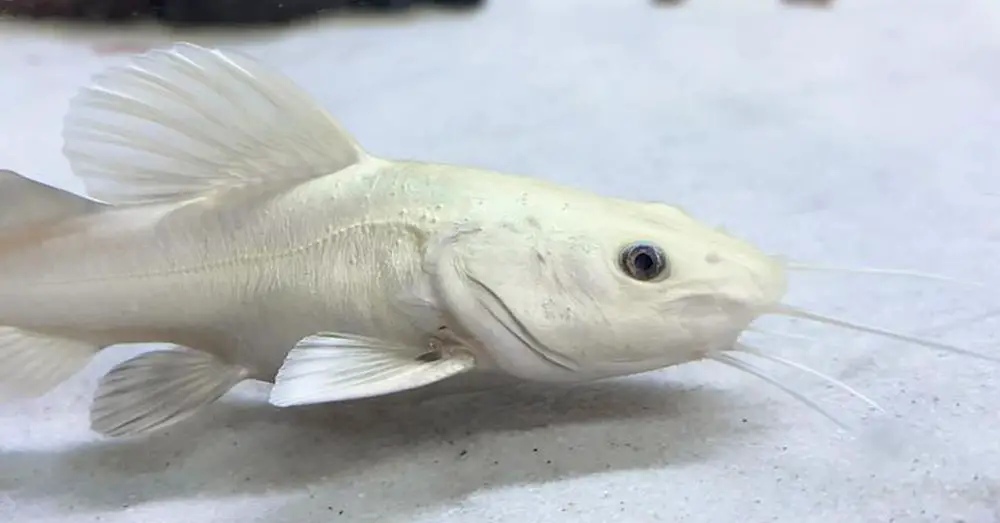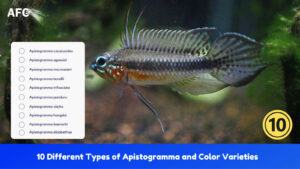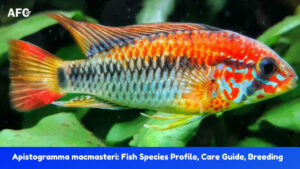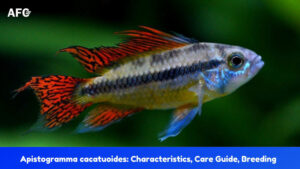For many fishkeepers, the Red-tailed Catfish (Phractocephalus hemioliopterus) is a massive and attractive catfish specie to have.
This fish can be easily recognized with its long barbels, distinguishing red tail, and white belly. However, there are several rare color morph varies available in the aquarium hobby market.
The Platinum Redtail Catfish is one of the most popular morphs that is highly sought after by many passionate hobbyists, but sadly this variant often comes with an expensive price tag.
If you want to bring home this amazing Platinum Redtail Catfish, you should be prepared for a set of challenges due to their size and high price.
This guide will cover everything there about Platinum Redtail Catfish, topics like care, size, tank mates, and more.
Species Summary
Redtail Catfish (Phractocephalus hemioliopterus) is one of the larger fish in the Amazon Basin, also known as the South American Red Tailed Catfish, Redtail Catfish, and Banana Catfish.
This species was first described in 1801. Although it is native to the Amazon river basin, it is also found in Colombia, Guyana, Brazil, Venezuela, Ecuador, Peru, and Bolivia.
Being the only member of the genus Phractocephalus, this fish has been traded for many years.
The Platinum Redtail Catfish is a color morph variant, often referred to as leucistic. The term “Platinum” and “Leucistic” are generally used to describe the specimens with partial pigmentation loss – causing white or pale coloration on their body. Technically, these two terms are too “blanket” these days.
| Scientific Name: | Phractocephalus hemioliopterus |
| Common Name: | Platinum Redtail Catfish |
| Care Level: | Intermediate |
| Lifespan: | 15 – 20 years |
| Max Size: | 5 ft 11 in (1.8 m) |
| Temperature: | 68.0 to 79.0° F |
| PH: | 6.0 – 7.5 |
| Diet: | Omnivorous |
| Minimum Tank Size: | 2,000 gallons |
| Temperament: | Aggressive |
Author notes: Like many other species, an actual "platinum" Redtail Catfish will not color morph at any time, and a true "Leucistic" Redtail Catfish still has black eyes.
Lifespan
The average Platinum Redtail Catfish lifespan is around 15 – 20 years in captivity. This is a pretty long lifespan for freshwater fish. They can often outlive their expected years in the wild.
Although it’s often reported, it’s difficult to define a species’ maximum lifespan. Many factors can contribute to the lifespan of Platinum Redtail Catfish, like water quality, diet, stress, and more.
As long as you feed them correctly and have good water conditions and a de-stressed environment, they will be a part of your family for many years to come.
Appearance

As its common name tells, the most significant difference between the Platinum Redtail Catfish and the common Redtail Catfish is its coloration. The main color of their body is ivory with smattering gold highlights.
Sometimes, you might notice some specimens display a yellow or golden color; they are xanthic, not Platinum Redtail Catfish.
According to Seriouslyfish,
Xanthic: Having a yellow or golden color; is a desirable and selectively-bred mutation in certain ornamental fishes but can also occur naturally.
Some golden/xanthic specimens have some “pied” or “piebald” on their back, and they can change the pigment spots as they age.
The Platinum morph variant still has the same long barbels, arrow-shaped body, flat belly, and a compressed tail. Their dorsal, pelvic, and anal fins have slight traces of black, but the edge of the tail fin has its characteristic red hue.
This Platinum Redtail Catfish is truly a magnificent and unique-looking fish that will stand out in any freshwater aquarium.
Platinum Redtail Catfish Size
The average Platinum Redtail Catfish size is around 3 ft 6 in – 4 ft 6 in (1 m – 1.4 m). Some specimens can grow to lengths of about 5 ft 11 in (1.8 m ), but it’s rare.
Their massive adult size makes them one of the largest freshwater fish in the world, and their long barbels can also add an extra few feet to their total Length. Therefore, this species is not unsuitable for most home aquariums.
In fact, an indoor pond is often necessary to house these fish when they’re fully grown. Most of us are not fortunate enough to have an indoor pond in our homes, so the best bet is to purchase a juvenile Platinum Redtail Catfish and rehome them to an outdoor pond when they’ve outgrown their indoor aquarium. Of course, the climate in your area matters.
Juveniles will quickly outgrow their tank. Owners have reported their fish growing about 2 inches per month during their first year, and some even say they went from 1 inch to 16” in 4 months.
Care And Tank Set-Up
With such large adult sizes, Platinum Redtail Catfish is not a beginner fish by any means. They require a lot of care and a large tank to accommodate them when they’re fully grown.
Like many other long-whiskered members from the Pimelodidae family, the Platinum Redtail Catfish are solitary slow-moving fish and territorial with their own kind. They spend most of their time at the bottom of the tank searching for food.
Platinum Redtail Catfish Tank Size
The minimum tank size for an adult Platinum Redtail Catfish is at least 2,000 gallons. The actual tank size depends on your fish’s purchase size and growth rate.
The typical purchase size of Platinum Redtail Catfish is around 3-5 inches. With their fast growth rate, they can reach 2 feet in Length their first year, 3 feet by their second year, and 4 feet or more in 4-5 years as long as you provide them with a good diet and ample room.
A rule of thumb for determining a Platinum Redtail Catfish’s aquarium size is a 4xL by 2xL footprint, where L means the Length of your fish. For example, if you have a 2 feet RTC, you would need an 8 x 4 feet tank (approximately 500 gallons). This is a bare minimum. The bigger the tank is, the better.
Water Conditions
The Platinum Redtail Catfish is a freshwater fish that is found only in larger rivers, streams, and lakes. Maintaining stable water parameters is critical to the health of your Platinum Redtail Catfish, and it’s not an easy task for such a large fish.
Luckily, these fish are quite hardy and can thrive in standard tropical conditions.
The following are the recommended water parameters:
- pH: 6.0 – 7.5
- Temp: 68.0 to 79.0° F
- Ammonia: 0ppm
- Nitrite: 0ppm
- Nitrate: <30ppm
Décor And Plants
The best way to have your Platinum Redtail Catfish happy is proactively to give them their natural habitat. They don’t have any particular preference when it comes to décor, but you may want to avoid anything that might tear their long barbels.
These large fish are more likely to destroy or rearrange your entire tank than they are to appreciate the subtle nuances of your latest aquascaping project. Large chunks of bogwood and smooth rocks are a good choice.
Platinum Redtail Catfish are nocturnal fish. They will hunt for food at night and get very sluggish during the day. To make them feel safe and comfortable, the lighting should be subdued.
So, if you’re thinking of getting a Platinum Redtail Catfish, don’t spend too much time worrying about the perfect aquascape. Your fish will be happy with whatever you choose – as long as it’s big enough for them to swim around in.
Food & Diet
Feeding is another challenge when you have a Platinum Redtail Catfish. They are not fussy eaters, but their size means they need a lot of food. These fish are opportunistic predators and will eat anything they can fit in their mouths.
In the wild, their diet consists of small fish, insects, crustaceans, and mollusks. Being omnivorous fish, you can give them a varied diet in captivity, but they prefer meaty foods.
To make your juveniles grow fast, some of the recommended food include:
- Feeder guppies
- Bloodworms
- Live or frozen Shrimp
- Fruits, vegetables
- High-quality Pellet (Hikari Massivore)
- Superior Benefits Over Live Foods: Specially developed for the needs of most carnivorous fish, without...
- Extremely Palatable: Developed after extensive study and analysis of the sense of sight, smell and taste...
- An X-Large Pellet Big Fish Love: A porous pellet that softens quickly by rapidly absorbing water. This...
- Natural Beauty They Desire: Most monster fish come from the natural environments high in UV which...
- Developed, produced and packaged in our facilities so we can be assured you'll always get the Hikari...
However, a few things to keep in mind when feeding your Platinum Redtail Catfish:
- Don’t overfeed them. Overfeeding is the most common cause of death in this species.
- These fish will eat anything that fits in their mouths, including aquarium heaters and filter kits.
- Don’t feed them meat that comes from a mammal, including beef, pork, and chicken, as the lipid content is too high and can cause digestive disorders.
- Be cautious with live fish that are not properly quarantined as they might be carrying diseases.
Platinum Redtail Catfish Tank Mates
The Platinum Red-tailed Catfish are a good community fish. And while that is mostly true, there is one caveat: their tank mates must be of a similar size.
However, they are also territorial with their own kind and other members from the Pimelodidae family. As a result, it’s best to keep them alone in a very large tank.
Breeding
Unfortunately, there are no reports of the Platinum Redtail Catfish being bred in captivity. And considering their size and the challenges of keeping them healthy, it’s unlikely that anyone will be able to breed them any time soon successfully.
Final Thoughts
The Platinum Redtail Catfish is a beautiful fish that is sure to impress anyone who sees it. But, these fish are not for everyone. They require a lot of space, stable water parameters, a varied diet, and financial responsibility for their potential full lifespan (20 years or so).
If you think you can provide everything they need, then add one of these majestic fish to your collection. Just be sure to do your research first and be prepared for the challenges that come with keeping them.
Don’t hesitate to drop us a line if you need any tips or advice about Platinum Redtail Catfish care. After all, there’s nothing we love more than talking about our favorite fish species.





